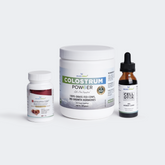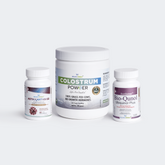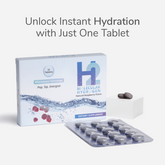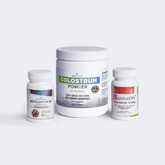Estimated Reading Time: 7 minutes
|Wait, Why Are We Talking About the "Sunshine Vitamin"?
Vitamin D isn’t just about bones and milk commercials. It’s essential for mood, immunity, energy, and more. But here’s the kicker: nearly 1 in 3 people are running low, and most have no clue.
Why? Because vitamin D deficiency symptoms don’t always scream. Sometimes, it whispers; through fatigue, mystery aches, or just feeling... off.
Let’s break it down.
First, What Does Vitamin D Do?
This powerhouse supports:
-
Calcium absorption (your bones need this to stay strong)
-
Muscle function
-
Immune system regulation (fewer sick days, stronger defenses)
-
Mood and brain health (yes, the winter blues are real)
-
Hormone balance
Did You Know?
Vitamin D acts more like a hormone than a regular vitamin. It has receptors in nearly every tissue of your body.
Basically, vitamin D helps your body function like it’s supposed to.
Vitamin D Deficiency Symptoms: What to Watch For
Think your vitamin D might be running low? Here's what your body might be trying to tell you:
|
Common Symptoms |
Why It Happens |
|
Fatigue or low energy |
Your cells struggle without enough D |
|
Bone or muscle aches |
Calcium isn’t absorbed well → weak bones, sore muscles |
|
Frequent colds or infections |
The immune system needs D to activate defense cells |
|
Mood swings, anxiety, or low mood |
Vitamin D affects serotonin (your happy hormone) |
|
Hair thinning or loss |
Linked to hormonal shifts when D levels drop |
|
Poor wound healing |
Vitamin D deficiency → impairs tissue repair + immune response → slows healing of wounds and cuts. |
Weird Symptoms of Vitamin D Deficiency (That Often Get Missed)
Not everything about low D is textbook. Some unexpected signs include:
-
Burning sensation in your mouth
-
Sweaty scalp (even when you’re not hot)
-
Brain fog or forgetfulness
-
Ringing in your ears
-
“Pins-and-needles” tingling in fingers and toes (may indicate nerve effects)
-
Unexplained toothaches or a weak grip
-
Itchy skin (especially in winter)
Yep, it gets weird. And yes, it could be your vitamin levels, not your imagination.
Low Vitamin D Symptoms in Females – What’s Different?
Hormonal shifts make women even more sensitive to vitamin D fluctuations. Women may experience:
-
PMS or worsened period pain
-
Fertility issues or irregular cycles
-
Increased risk of thyroid imbalances
-
Bone thinning after 40
Fun Fact:
Studies show vitamin D helps with estrogen balance. Many women feel emotionally better after correcting their deficiency.
Severe Vitamin D Deficiency Symptoms
When deficiency goes unchecked for too long, it can lead to:
-
Osteomalacia (bone softening in adults)
-
Higher risk of fractures (even with minor falls)
-
In children: Rickets (bone deformities)
-
Muscle weakness so severe that it affects walking
-
Chronic fatigue
-
Depression-like symptoms
-
Seizures or breathing issues
This isn’t just about getting more sunlight; it can impact your whole body.
Science Says
Some studies found that low vitamin D levels were significantly associated with higher risks of autoimmune disease, depression, and even cardiovascular issues. The best part? Supplementing may improve many of these markers.
What Causes Vitamin D Deficiency?
Here’s why your levels might be slipping:
1] Limited Sun Exposure
If you are living in northern climates, an indoorsy type, or a sunscreen lover; you’re probably not making enough D naturally.
2] Darker Skin Tone
Melanin reduces the skin’s ability to make vitamin D. So, people with medium to dark skin need more sunlight to produce the same amount.
3] Certain Medical Conditions
Digestive issues like celiac, Crohn’s disease, or even chronic kidney/liver problems can interfere with vitamin D absorption.
4] Low-Fat Diets or Fat Malabsorption
Low-fat diets or fat malabsorption conditions can limit the body’s ability to absorb vitamin D from food and supplements, leading to deficiency.
5] Certain Medications (like steroids)
Some medicines can make it harder for your body to use vitamin D properly, which can bring your levels down over time.
6] Aging
As you age, your skin produces vitamin D less efficiently, lowering overall levels naturally.
7] Obesity
Vitamin D is fat-soluble. In overweight individuals, it gets "trapped" in fat cells and isn’t available for the body to use.
Myth Buster:
“I go outside every day, so I’m good.”
Not so fast. Unless you're getting 5–30 minutes of sun exposure on your face, arms, hands, or legs without sunscreen, between 10 a.m. and 4 p.m., at least a couple of times a week, you might still be low; especially in winter or if you have darker skin.
Treatment: How to Refill Your Vitamin D
Here are some simple steps to help you boost and keep your vitamin D levels on track.
Step 1: Test Your Levels
Ask your doctor for a 25(OH)D blood test. Optimal range? Around 40–60 ng/mL.
Step 2: Supplement Smartly
Most people need approximately 600 IU daily, but your needs might be higher if you're deficient. Work with your doctor.
Caution:
More is not always better. Super-high doses of D can lead to toxicity over time; causing calcium buildup and kidney problems. Stick with a medically guided plan.
Step 3: Eat Some D!
Natural food sources of vitamin D include:
-
Fatty fish (salmon, sardines)
-
Egg yolks
-
Fortified dairy or plant milks
-
Mushrooms exposed to sunlight (yes, that’s a thing)
-
Cod liver oil
Quick Tip:
Always take vitamin D with food; preferably something with fat (like avocado, nuts, or eggs) to help with absorption.
Step 4: Maintain a Healthy Lifestyle
A few key things can make a big difference:
-
Maintain a healthy weight.
-
Treat gut disorders that impair absorption.
-
Don’t skip your supplements if prescribed.
-
Check levels every 6–12 months if you’ve been low before
Also Read: Complete Guide to Sources of Vitamin A B C D E and K
Don’t Overthink It — Just Get Checked
Vitamin D deficiency can sneak up on anyone; and it doesn’t mean you’re doing something wrong. Between long winters, packed schedules, sunscreen use, and life mostly lived indoors, it’s easy for levels to dip without you even realizing it.
The key is awareness. If you’re feeling off; low energy, mood swings, body aches: these could be signs of vitamin D deficiency symptoms. The good news? A simple blood test can give you answers, and getting on top of it could make a real difference in how you feel day to day.
Key Takeaways
-
Vitamin D is critical for bones, mood, muscles, and immune defense.
-
Symptoms of vitamin D deficiency can range from fatigue and aches to weird ones like hair loss or brain fog.
-
Women may notice hormonal impacts and increased PMS or period pain.
-
Testing is the only way to know for sure—get your 25(OH)D levels checked.
-
Treat with smart supplementation + food + lifestyle, not guesswork.
Disclaimer: This blog is for informational purposes only and does not provide medical advice. Always consult a healthcare professional before making changes to your diet or health routine. Individual results may vary.
References
-
Sizar O, Khare S, Goyal A, Bansal P, Givler A. Vitamin D Deficiency. PubMed. Published 2023. https://www.ncbi.nlm.nih.gov/books/NBK532266/
-
Voltan G, Cannito M, Ferrarese M, Ceccato F, Camozzi V. Vitamin D: An Overview of Gene Regulation, Ranging from Metabolism to Genomic Effects. Genes. 2023;14(9):1691-1691. https://doi.org/10.3390/genes14091691
-
MedlinePlus. Vitamin D Deficiency. Medlineplus.gov. Published 2019. https://medlineplus.gov/vitaminddeficiency.html
-
Gu Y, Baldwin S, Canning C. Hypovitaminosis D, objective oral dryness, and fungal hyphae as three precipitating factors for a subset of secondary burning mouth syndrome. Heliyon. 2023;9(9):e19954-e19954. https://doi.org/10.1016/j.heliyon.2023.e19954
-
Nocini R, Henry BM, Mattiuzzi C, Lippi G. Serum Vitamin D Concentration Is Lower in Patients with Tinnitus: A Meta-Analysis of Observational Studies. Diagnostics. 2023;13(6):1037-1037. https://doi.org/10.3390/diagnostics13061037
-
Sari A, Akdoğan Altun Z, Arifoglu Karaman C, Bilir Kaya B, Durmus B. Does Vitamin D Affect Diabetic Neuropathic Pain and Balance? Journal of Pain Research. 2020;Volume 13:171-179. https://doi.org/10.2147/jpr.s203176
-
Li CP, Huang SC, Hsiao Y, Tsai RY. Evaluating the Role of Vitamin D in Alleviating Chronic Pruritus: A Meta-Analysis. International Journal of Molecular Sciences. 2024;25(18):9983-9983. https://doi.org/10.3390/ijms25189983
-
Várbíró S, Takács I, Tűű L, et al. Effects of Vitamin D on Fertility, Pregnancy and Polycystic Ovary Syndrome-A Review. Nutrients. 2022;14(8):1649. https://doi.org/10.3390/nu14081649
-
Crescioli C. The Role of Estrogens and Vitamin D in Cardiomyocyte Protection: A Female Perspective. Biomolecules. 2021;11(12):1815-1815. https://doi.org/10.3390/biom11121815
-
Dupuis ML, Pagano MT, Pierdominici M, Ortona E. The role of vitamin D in autoimmune diseases: could sex make the difference? Biology of Sex Differences. 2021;12(1). https://doi.org/10.1186/s13293-021-00358-3
-
Akpınar Ş, Karadağ MG. Is Vitamin D Important in Anxiety or Depression? What Is the Truth? Current Nutrition Reports. 2022;11(4). https://doi.org/10.1007/s13668-022-00441-0
-
Haider F, Ghafoor H, Hassan OF, Farooqui K, Bel Khair AOM, Shoaib F. Vitamin D and Cardiovascular Diseases: An Update. Cureus. 2023;15(11):e49734. https://doi.org/10.7759/cureus.49734
-
Wakeman M. A Literature Review of the Potential Impact of Medication on Vitamin D Status. Risk Management and Healthcare Policy. 2021;Volume 14:3357-3381. https://doi.org/10.2147/rmhp.s316897
-
National Institutes of Health. Vitamin D. National Institutes of Health. Published 2024. https://ods.od.nih.gov/factsheets/VitaminD-HealthProfessional/
-
Dawson-Hughes B, Harris SS, Lichtenstein AH, Dolnikowski G, Palermo NJ, Rasmussen H. Dietary fat increases vitamin D-3 absorption. Journal of the Academy of Nutrition and Dietetics. 2015;115(2):225-230. https://doi.org/10.1016/j.jand.2014.09.014






































